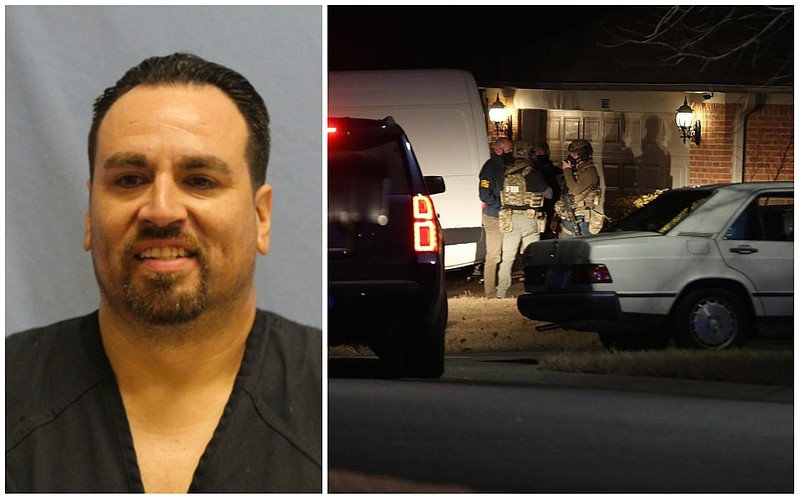WASHINGTON -- A Conway man accused of beating a police officer with a flagpole during the Jan. 6 storming of the U.S. Capitol was formally arraigned Wednesday, pleading innocent to seven federal charges.
Peter Francis Stager appeared by video in the U.S. District Court for the District of Columbia. He is currently being held in the District of Columbia jail.
Asked whether he would waive a formal reading of the indictment, Stager paused for a few seconds, and then said, "No, sir."
At that point, defense attorney David Benowitz of Washington intervened, telling U.S. District Judge Emmet G. Sullivan, "If I could just interject on behalf of Mr. Stager, we waive a formal reading of the indictment and plead not guilty to each count."
Tuesday's initial status conference focused on the cases of Stager and Clayton Ray Mullins, a Kentucky man accused of assaulting another member of law enforcement.
Mullins, who reportedly "violently pulled" on an officer's leg before the officer was dragged down the Capitol steps, has been placed on home detention while awaiting trial in the District of Columbia.
Attorneys for both men requested more time to review evidence in the complicated case.
The next hearing for both was set for May 5. Sullivan, with the agreement of the parties, said the time until then will be excluded from speedy-trial provisions.
According to the federal court record in the District of Columbia, a federal grand jury has indicted Stager on seven charges:
• 18 U.S.C. 1512(c)(2) and 2; obstruction of an official proceeding, and aiding and abetting.
• 18 U.S.C. 111(a)(1) and (b); assaulting, resisting or impeding certain officers using a dangerous weapon.
• 18 U.S.C. 231(a)(3); civil disorder.
• 18 U.S.C. 1752(a)(1) and (b)(1)(A); entering and remaining in a restricted building or grounds with a deadly or dangerous weapon.
• 18 U.S.C. 1752(a)(2) and (b)(1)(A); disorderly and disruptive conduct in a restricted building or grounds with a deadly or dangerous weapon.
• 18 U.S.C. 1752(a)(4) and (b)(1)(A); engaging in physical violence in a restricted building or grounds with a deadly or dangerous weapon.
• 40 U.S.C. 5104(e)(2)(F); violent entry and disorderly conduct in a Capitol building.
Video from a Twitter thread shows a man, reported to be Stager, repeatedly assaulting a member of the Washington, D.C. Metropolitan Police Department. The American flag is still attached as the pole strikes its target again and again.
The pole was a "deadly or dangerous weapon" that was used to "forcibly assault, resist, impose, impede, intimidate and interfere with an officer," the indictment states.
If convicted, Stager faces a maximum penalty of 20 years in prison under 18 U.S.C. 1512(c)(2) and another 20 years under 18 U.S.C. 111(a)(1) and (b).
In another video, a man identified as Stager can be heard saying, "everybody in there is a treasonous traitor."
Referring to the site where Congress and Vice President Mike Pence had gathered to count the 2020 electoral votes from the Nov. 3 election results, the man says: "Death is the only remedy for what's in that building."
The Jan. 6 riot escalated from a "Stop the Steal" rally in support of former President Donald Trump. The mob entered the Capitol and attempted to prevent Congress from recognizing Democrat Joe Biden's victory in the presidential election. Five people died during the riot while members of Congress cowered in their offices and in bathrooms.
Stager was arrested Jan. 14 in Conway on one count of obstructing a police officer from his duties during a civil disorder.
He was then indicted Jan. 29.
With hundreds of defendants awaiting trials for their roles in the Jan. 6 insurrection and copious amounts of video evidence, the courts will have to determine how to handle all of the evidence exhibits.
"We have YouTube issues," Sullivan told participants in Wednesday's hearings. "Should evidence, should depictions be placed on YouTube?," he asked rhetorically.
"We're all struggling with what to do," he said. "My understanding is that maybe the government and [the office of federal public defender] are trying to negotiate what to do."
The issues aren't easy, Sullivan said.
"I mean, you have all these conflicting principles," he said. "You've got, obviously, defendants' right to a fair trial. You've got the public's right to know what the court is relying upon in order to reach whatever decision the court reaches. And balancing those is difficult."
Information for this article was contributed by Bill Bowden of the Arkansas Democrat-Gazette.
